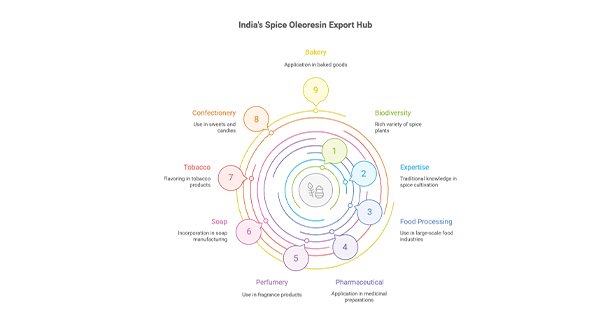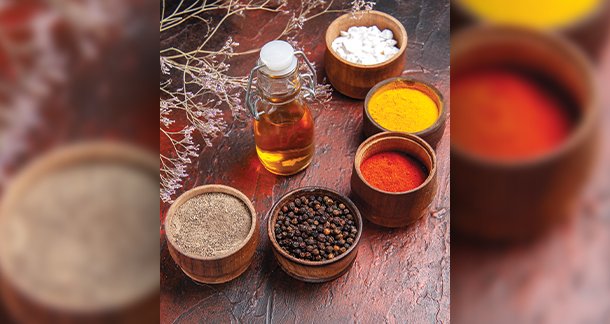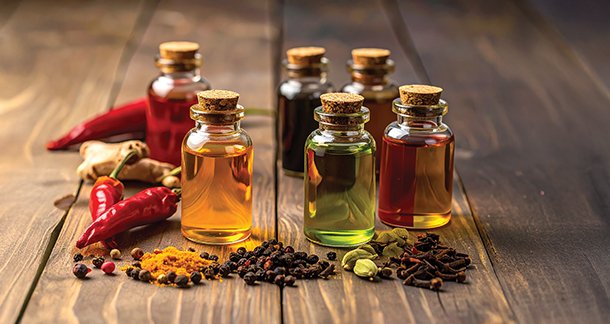The global spice oleoresin market is experiencing significant growth, driven by a surging demand for natural ingredients in the processed food and fragrance industries. Consumers’ increasing health consciousness has led to a preference for natural colouring and flavouring agents over artificial alternatives.
Spice oleoresins, which are highly concentrated liquid extracts of raw spices, offer a complete and consistent flavour profile, including both volatile and non-volatile constituents. These botanical extracts are obtained through a solvent extraction process, followed by solvent removal. Their advantages over traditional whole or ground spices are numerous: enhanced visual appeal, superior and consistent flavour, longer shelf life, cost-effectiveness, and ease of storage and transport due to their concentrated nature. They also boast a lower microbial load and can effectively replace traditional spices in most applications where the physical appearance or bulk of the spice is not crucial.
A Legacy of Innovation and Market Dominance
The commercialisation of spice oil and oleoresin extraction began in Germany in the early 20th century. India, however, has emerged as a global leader in this sector, controlling a remarkable 60% of the 13,500-tonne global spice oleoresin market. Pioneering efforts in India, such as the establishment of oleoresin manufacturing in 1969 by Kancor Ingredients (formerly Bombay Oil Industries), followed by companies like Synthite Industries and Plant Lipids, laid the groundwork for this dominance. Notably, the Indian extraction procedure, developed by the Central Food Technological Research Institute, is a unique two-stage process that effectively separates essential oils.
Key Indian players in this market include Synthite Industries, Plant Lipids, Kancor Ingredients, Venkatramna Industries, Silverline Chemicals Ltd, Agnes Herbs, Adani Pharmachem Private Limited, and Ozone Naturals. While India maintains a strong lead, China has emerged as a significant competitor, particularly in the paprika oleoresin segment.

Diverse Applications Across Industries
Spice oleoresins are versatile and find extensive applications across various industries, serving as base flavours or components of complex flavour profiles. They can be used directly or blended to create a wide range of seasonings, flavours, and perfumes.
- Food and Beverage Industry: They are widely used as colouring agents in products like butter, meat, cheese, snacks, jellies, jams, poultry feeds, and frozen foods. They are also crucial in beverages, meat canning, confectionery, sauces, and as a base for numerous seasonings.
- Healthcare and Personal Care Industries: Their natural properties and consistent composition make them valuable in pharmaceuticals, cosmetics, and personal care products.
Key Oleoresins
Black Pepper Oleoresin: Derived from black pepper berries, this olive-green liquid offers the characteristic pungent taste and aroma of pepper due to its piperine and volatile oil content. Beyond its use in flavouring meat products and as a preservative, it’s gaining traction in traditional medicinal systems like Ayurveda for treating various ailments, including digestive issues and joint pains. The global market for black pepper oleoresin is experiencing significant growth driven by its diverse applications.
Paprika Oleoresin: Extracted from red paprika fruits, this oleoresin is a vital natural colouring and flavouring agent. Its colour comes from capsanthin and capsorubin, while capsaicin provides pungency. It’s extensively used to colour and flavour a wide array of food products, including meat products, confectionery, snacks, soups, sauces, and bakery items. The demand is particularly high in regions with a strong preference for clean-label natural ingredients.
Cardamom Oleoresin: Obtained from cardamom seeds, this extract is characterised by its sweet-spicy, warming fragrance. It’s broadly used as a domestic spice, a fragrance component, and a flavour compound in various dishes, sweeteners, and curry products. In pharmaceuticals, it’s recognised for treating digestive disorders and is also employed in personal care products and perfumes.

Market Growth and Future Outlook
The global spice oleoresin market is poised for steady growth. The market, valued at USD 1.44 billion in 2018, is projected to register a CAGR of 4.7% over the forecast period. This growth is fuelled by increasing consumption of processed meat, confectionery, and baked goods, as well as the rising demand for food additives and the proliferation of multi-cuisine restaurants worldwide.
Oleoresins’ superior properties—including uniform composition, consistent strength, absence of contaminants, ease of storage and transport, and longer shelf life—make them an increasingly attractive alternative to ground spices. Continuous research and development initiatives, particularly in introducing new varieties and improving quality for applications like aromatherapy, are expected to further augment market growth. As consumer demand for natural ingredients continues to rise, spice oleoresins are set to play an even more crucial role in shaping the flavours and colours of products across diverse industries.
In India, spice oleoresins are extensively utilised across various industries, primarily due to their concentrated form, consistent quality, extended shelf life, and superior hygienic standards compared to traditional raw or ground spices. Their most significant application lies within the food and beverage sector. Here, they are crucial as natural flavouring agents, imparting the authentic taste and aroma of various spices to a wide array of products. This includes processed foods like soups, sauces, dressings, and ready-to-eat meals, as well as meat and seafood products, confectionery, bakery items, dairy products, and snacks. Furthermore, they form the essential base for numerous compounded seasonings and ready-made spice blends, a growing segment in the Indian culinary landscape. Beyond flavouring, oleoresins like paprika and turmeric are widely employed as natural colouring agents in products such as butter, cheese, and various processed foods, while some, like black pepper oleoresin, also offer preservative qualities.

Beyond the culinary world, spice oleoresins find significant application in the pharmaceutical and nutraceutical industries. They are incorporated into a variety of medicines and health supplements, not only to mask unpleasant tastes or provide appealing aromas but also for their inherent medicinal properties. For instance, black pepper oleoresin is a component in traditional Indian medicinal systems like Ayurveda, Siddha, and Unani, used for addressing various ailments. Similarly, cardamom oleoresin is recognised for its benefits in treating digestive issues. Their use extends to formulations designed to address specific illnesses, and as active ingredients in carminative, stomachic, and stimulant preparations.
Moreover, the cosmetics and personal care industry in India increasingly utilises spice oleoresins. They are valued for their natural fragrances and potential skin benefits, finding their way into products like creams, soaps, shampoos, and perfumes. This trend is driven by a growing consumer preference for natural and herbal ingredients in their personal care routines. The fragrance industry also leverages oleoresins for their rich and true-to-origin scent profiles in products such as air fresheners and specialised perfumes. Finally, the animal feed sector indirectly benefits from oleoresin extraction, as the residual spice powder, rich in nutrients, can be used in animal feed formulations, contributing to improved animal performance and productivity. While the direct use of oleoresins in Indian household cooking is still evolving, their integral role in the organised food processing sector means they are a substantial, albeit often unseen, presence in the modern Indian kitchen through processed foods and ready-to-use products.



